Golden discovery: Archaeologists discover astonishing haul 'linked to Alexander the Great' in network of tombs in Bulgaria
Sam Webb
Source - http://www.dailymail.co.uk/news/article-2231461/A-golden-discovery-Bulgarian-archaelogists-discover-astonishing-artifacts-linked-Alexander-Great-vast-network-tombs.html
- Beautifully-preserved treasures found in Bulgarian historical site
- Thracian artefacts are more than 2,000 years old
- May be linked to Phillip II of Macedon, Alexander the Great's father
Archaeologists have unearthed ancient golden artefacts, including a tiara with animal motifs and a horse head piece, during excavation works at a Thracian tomb in northern Bulgaria.
The significant finds are dated back to the end of the fourth or the beginning of the third century BC and were found in the biggest of 150 ancient tombs of a Thracian tribe, the Getae, that was in contact with the ancient Greeks.
The findings, at the Omurtag mount near the village of Sveshatari, also included a golden ring, 44 applications of female figures as well as 100 golden buttons.
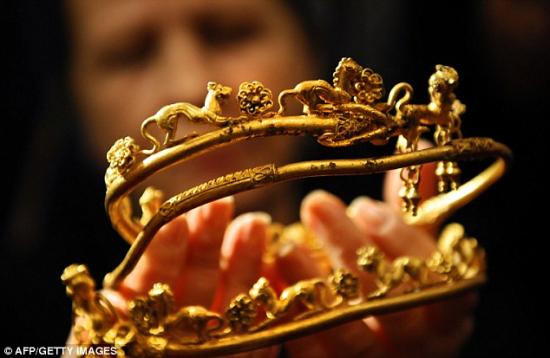
Touching history: An archaeologist displays a gold tiara engraved with a lion's head and other animals found at the Bulgarian tomb. It is part of an incredible and historically-significant haul
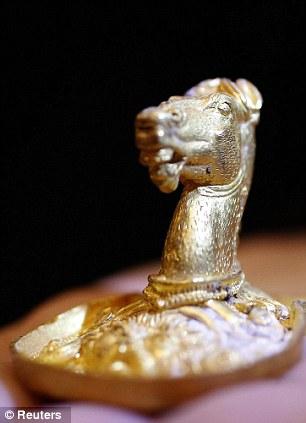 A golden horse head piece
A golden horse head piece
'These are amazing findings from the apogee of the rule of the Getae,' said Diana Gergova, head of the archaeologist team at the site of the ancient Getic burial complex situated near the village of Sveshtari, some 400 km northeast from Sofia.
'From what we see up to now, the tomb may be linked with the first known Getic ruler Cothelas,' said Gergova, a renowned researcher of Thracian culture with the Sofia-based National Archaeology Institute.
Gergova explains that it seemed the treasure was wrapped in a gold-woven cloth because a number of gold threads were discovered nearby.
These were, most likely, remnants from a ritual burial, said the professor, adding the team expects to discover a huge burial ground, probably related to the funeral of the Gath ruler Kotela, one of the father-in-laws of Philip II of Macedon - Alexander the Great's father.
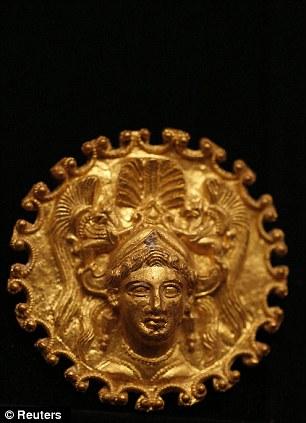
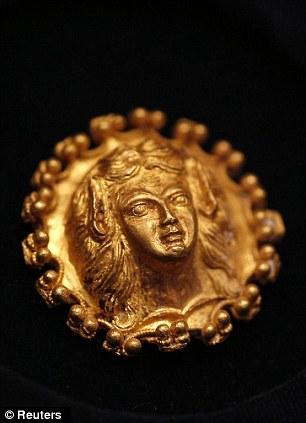
Crafted: A pair of golden artefacts that date back to the end of the fourth or beginning of the third century BC
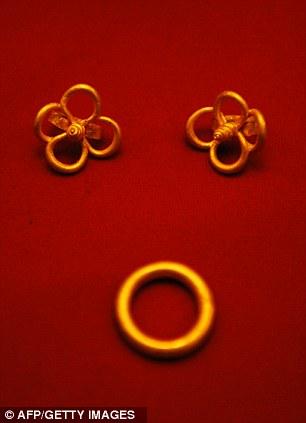

Valuable: The artefacts are Thracian. Modern Bulgaria is viewed as the geographical cradle of Thracian civilisation
She notes this is a unique find, never before discovered in Bulgaria, according to Novinite.
One of the tombs there, known as the Tomb of Sveshtari, is included in the World Heritage List of U.N. education and culture agency, UNESCO, for its unique architectural decor with half-human, half-plant female figures and painted murals.
The find is so significant that Bulgarian Prime Minister Boyko Borisov has arranged to see it at the National Archaeological Museum in Sofia where the treasure is currently placed.
The Thracians, ruled by a powerful warrior aristocracy rich in gold treasures, inhabited an area extending over modern Romania and Bulgaria, northern Greece and the European part of Turkey from as early as 4,000 BC.
They lived on the fringes of the Greek and Roman civilisations, often intermingling and clashing with the more advanced cultures until they were absorbed into the Roman Empire around 45 AD.
Archaeologists have discovered a large number of artefacts in Bulgaria's Thracian tombs in recent decades, providing most of what is known of their culture, as they had no written language and left no enduring records.

Insight: The excavations near the village of Sveshtari have been a rich source of information about the mysterious Thracians